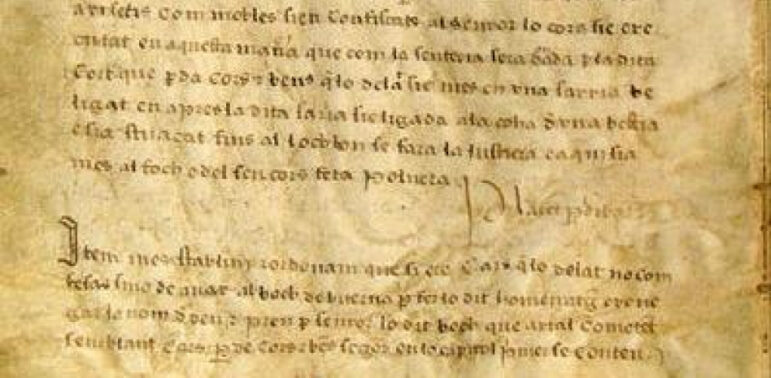BARCELONA – The oldest Witchcraft law in European history is being remembered at a conference organized by the University of Barcelona later this summer. The conference is a collaboration of the university’s Institut de Recerca en Cultures Medievals (IRCVM) with the Les Valls d’Àneu and the Dansàneu festival. The event remembers “the first legal condemnation of the crime of witchcraft in Europe.”
The Malleus Maleficiarum, also known as The Hammer of Witches, is a treatise on witchcraft and is well-known to modern Witches and persecuted communities in history as having played a crucial role in the witch hunts, principally during the early modern period.
Editorial note: The Wild Hunt reserves the capitalization of Witches and Witchcraft for modern practitioners.
Written by Heinrich Kramer, a German Catholic clergyman, in 1486, the Malleus Maleficiarum was intended as a guide for the identification, prosecution, and punishment of witches. Kramer wrote Kramer wrote the Malleus Maleficarum after being expelled from Innsbruck by the local bishop. That expulsion was due to charges of illegal behavior against Kramer and his excessive focus on the sexual habits of one of the accused, Helena Scheuberin, which caused tribunal members to suspend the trial.
Kramer sought to provide a theological justification for the persecution of witches, drawing on various sources, including the Bible and earlier church writings such as Exodus 22:18 “18 Thou shalt not suffer a witch to live.” The book also outlined legal procedures to ensure that trials were conducted in accordance with both secular and ecclesiastical law.
But, as William Burns wrote in Witch Hunts in Europe and America: An Encyclopedia (2003), the books also urged communities, accusers, and inquisitors “to adopt torture, leading questions, the admission of denunciation as valid evidence, and other Inquisitorial practices to achieve swift results. Moreover, the authors insist that the death penalty for convicted witches is the only sure remedy against witchcraft. They maintain that the lesser penalty of banishment prescribed by Canon Episcopi for those convicted of harmful sorcery does not apply to the new breed of witches, whose unprecedented evil justifies capital punishment.”
The Malleus nevertheless significantly influenced the witch hunts in Europe between the 15th and 17th centuries. It was widely distributed and referenced by witch hunters and inquisitors.
It is also often presumed to be the oldest articulation of anti-witchcraft legislation.

Image of the ‘Book of Customs and Ordinances’ Archive of the Crown of Aragon
But that is not the case. Over sixty years before the publication of the Malleus Maleficiarum, a law regarding witchcraft was “inserted in the Llibre dels Costums i Ordinacions,” (Book of Customs and Ordinances) of the Catalonian town of Lleida in 1424. It is now recognized as “the first document preserved in Europe with a regulatory nature. which orders and condemns participation in witch meetings.”
Although few by comparison to the rest of Europe and especially southwestern Germany, the witch trials in Spain were launched as part of the Inquisition in 1526 after the Navarre Witch Trial of 1525. The Spanish Inquisition established a witchcraft regulation stating that, while they acknowledged the reality of witches and their participation in the Sabbath of Satan, they recommended repentance over the death sentence for the condemned and prohibited the confiscation of their property. Witches were hanged not burned; and the last person persecuted for witchcraft in Spain was Maria Pujol in 1767, though witch trials mostly diminished by the mid-17th Century.
Ironically, Pau Castell, a professor of modern history at the University of Barcelona who is one of the conference organizers, told The Guardian in a previous interview that feudal lords said a confession alone was deemed sufficient proof of guilt, in cases involving the Inquisition those accused were often freed from lack of evidence.
Two years ago, the Catalan parliament passed a resolution pardoning some 1,000 individuals who were condemned for witchcraft in the region 400 years ago, most of whom were women who practiced folk medicine or were simply independent of men.
The organizers hope the University of Barcelona conference will honor the memory of women who endured persecution. The conference organizers wrote that they hope that, “With this initiative, its promoters want to recognize the historical uniqueness and legal weight of this text from the Àneu valley, as well as restore the memory of the women who were subject to repression and gender violence in the 15th century.”

Flag of Catalonia
The president of the Cultural Council of the Valls d’Àneu, Ferran Rella, said the conference is a reminder of the intransigence of terror and gender violence.
Natàlia Garriga, the Minister of Culture of the Generalitat, the autonomous government of the Catalonia region in northeast Spain that includes Barcelona, emphasized last Saturday during a press announcement the importance of this conference in generating fresh perspectives to examine women’s history in the context of witch hunts.
“The feminist movement and the vindication of a vision for gender equality have done their work, and one of the objectives of this year of activities is to restore the memory of the women who were the object of repression and violence,” Garriga said.
The conference will take place in Barcelona and Valls d’Àneu from July 4-6, 2024.
The Wild Hunt is not responsible for links to external content.
To join a conversation on this post:
Visit our The Wild Hunt subreddit! Point your favorite browser to https://www.reddit.com/r/The_Wild_Hunt_News/, then click “JOIN”. Make sure to click the bell, too, to be notified of new articles posted to our subreddit.